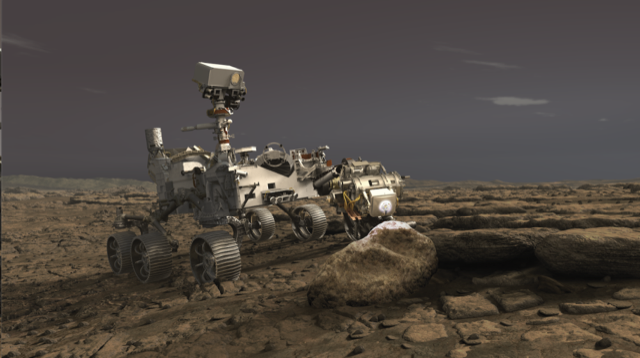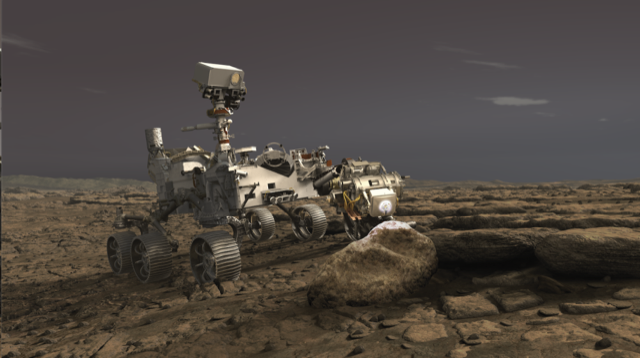Sound Speed Measured on Mars
Last February, the internet was awash with alien sounds after NASA’s Perseverance rover beamed back the first ever audio recordings of the red planet. Scientists have now analyzed additional recordings made by the rover, using them to measure the speed of sound on Mars for the first time. The results, which were presented two weeks ago by Baptiste Chide at the 53rd Lunar and Planetary Science Conference in Texas, confirm a predicted quirk of Mars’s atmosphere. The sound data also provide a new method for measuring the temperature of the planet’s atmosphere, complementing the rover’s primary temperature gauge.
The atmospheric pressure on the surface of Mars is 6 mbars, a tiny fraction of that on Earth, and some scientists thought that the atmosphere would be too thin to effectively propagate sound waves. “We were told there was nothing to record on Mars,” says Chide, who works at Los Alamos National Laboratory, New Mexico. “But that’s clearly not the case.” The first rover recording revealed a deep rumbling noise of the Martian wind, and subsequent recordings have picked up the sound of vibrations from the rover’s moving wheels.
The recordings that Chide and his colleagues analyzed are ones that capture tapping sounds as the rover zaps rocks with a laser. These laser shots are part of the SuperCam experiment, which probes the surface geology by recording both the light and sound from a laser-impacted rock. The SuperCam’s microphone sits 2.1 m above the planet’s surface. Chide and colleagues are able to determine the speed of sound on Mars by using the time lag between the laser hitting a rock and the resulting taps reaching the microphone.
The analysis gives the speed of sound on Mars to be about 240 m/s, making it significantly slower than the 340 m/s sound speed on Earth. But the Martian sound speed isn’t constant across the range of frequencies measured by the microphone. At around 400 Hz, the speed of sound increases suddenly by 10 m/s. Predicted by theory, this jump is a unique feature on Mars—the speed of sound is relatively constant on Earth over frequencies audible to humans.
The jump at 400 Hz could make it hard for humans on Mars to hold conversations or to listen to music played through a speaker. “The sounds would be distorted,” Chide says, because the high frequencies would reach your ears before the low frequencies. The composition of Mars’s atmosphere, which is mostly carbon dioxide, adds in another quirk: high frequencies are more strongly attenuated than low frequencies. Trying to talk to someone a few meters away would sound like you were “having a conversation through a wall,” Chide says. “You would hear mainly the bass frequencies.”
As well as studying sound properties, the team used the recordings to probe the temperature of Mars’s surface. Sound speed can be converted into temperature relatively easily, Chide says, using the ideal gas law and wind speed—something Perseverance also measures. Those conversions indicate that Mars’s temperature undergoes significant fluctuations as large as 10 K/s. The rover has another temperature-measuring instrument, called MEDA, which also detects fluctuations but with less time resolution. “Our technique allows us to study temperature changes in much more detail,” Chide says.
Now that the team has demonstrated this method of sound-speed detection, Chide says that “the fun will really start.” The team plans to make measurements over the course of a complete Martian year to see if the speed of sound changes during the winter months or during the dust storm season. They also plan to use the laser recordings to probe the physical properties of the rock that the laser is hitting. Looking further afield, Chide hopes that these measurements will encourage more research into the sound propagation on different planets. “We have shown that we can do atmospheric science with acoustics,” Chide says. “I hope that the next missions to Mars, Venus, and Titan will include microphones—they are the next generation of planetary instruments.”
–Katherine Wright
Katherine Wright is the Deputy Editor of Physics Magazine.





